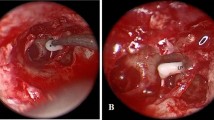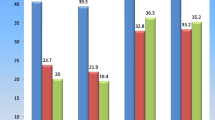Abstract
To analyze the results of repair defect of the ear canal with autologous bone containing periosteum and hearing reconstruction and postoperative inflation. Retrospective analysis of the 40 cases of surgeries conducted by senior surgeon. All cases received full open surgeries. Preoperative air conduction (AC) was 67.47 ± 14.32 dBHL, and GAP was 45.95 ± 12.63 dBHL. These cases were divided into two groups: the first 20 ears received repair surgery for radical mastoid cavity with bone slice containing periosteum combined with ear ossicle remodeling, namely the bone slice group. For another 20 ears, inflator was additionally used and the mastoid antrum cavity was inflated twice a day, namely the inflation group. Follow-up: 9–60 months (median follow-up of 26 months). Statistical analysis: U test was adopted. All ear canal showed a smooth appearance. Eight cases received CT scans and presenting re-gasification of attic and/or mastoid cavity. Hearing: AC of 47.32 ± 15.63 dBHL, and GAP of 18.28 ± 15.28 dBHL, both P values were <0.01 as compared with that before operation, and the difference was highly significant. 23 cases showed GAP <20 dB, and one case showed GAP >20 at follow-up, but narrowing was >30 dB, and these 24 cases were successful case, with a success rate = 60 %. 16 cases with GAP <10 dB, although 4 cases with GAP >10 dB, narrowing was >30 dB, thus the 20 cases were markedly effective, and with ratio = 50 %. The gap of 30 cases was narrowed more than 15 dB, although two cases showed gap narrowing less than 15 dB, postoperative GAP was less than 10 dB, both were valid, with an efficacy of 32/40 = 80 %, 18 cases (45 %) with AC <40 dBHL. Sub-group analysis: age: group P < 0.05 when the two groups were compared, difference in ages of the two groups were significant, and the age of the inflation group was older. Both GAP and AC of the two groups showed no significant difference before and after the surgery. One case in the bone slice group showed poor postoperative hearing, adhesion was found between the mesotympanum and attic in reoperation, and best result of GAP Close to less than 10 dB was obtained using the decomposition method after inflation. Bone slice containing periosteum can be used for reconstruct the normal ear canal. Auxiliary inflation of middle ear can even promote the tympanic re-gasification and hearing recovery.








Similar content being viewed by others
References
Reddy TN, Dutt SN, Shetty A, Maini S (2001) Treanscanal atticoaditotomy and transcortical mastoidectomy for cholesteatoma: the farrior-olaizola technique revisited. Ann Otol Rhinol Laryngol 110(8):739–745
Jackson CG, Glasscock ME 3rd, Nissen AJ et al (1985) Open mastoid procedures: contemporary indications and surgical technique. Laryngoscope 95(9 Pt 1):1037–1044
Jansen C (1968) The combined approach for tympanoplasty (report 10 years’ experience). J Laryngol Otol 82:779–793
Smith G (1969) Combined approach tympanoplasty. Arch Otolaryngol 89:250–251
Magliulo G, Amico RD, Fusconi M (2004) Reconstruction of old radical cavities and long-term results. J Otolaryngol 33(3):155–159
Deveze A, Rameh C, Puchol MS, Lafont B, Lavieille JP, Magnan J (2010) Rehabilitation of canal wall down mastoidectomy using a titanium ear canal implant. Otol Neurotol 31(2):220–224
Chen WW, Deng YX (2002) Review for otitis media with cholesteatoma. J Audiol Speech Pathol 10:40–41
Deng YX, Chen WW (2006) Observe the result of reconstruction for old radical cavities and adhering otitis. Chin J Otol 4:109–111
Chen WW, Deng YX, Tong J, Qiao Y, Cai XH, Wu JL et al (2009) Reconstruction of the posterior ear canal wall using periosteum-bone-plank and ossicular reconstruction following radical mastoidectomy. Chin J Otol 7(2):157–159
Chen WW, Deng YX, Tong J, Qiao Y, Zhong X, Zhang YH (2005) Observation of adhering otitis media operation result. Chin J Otorhinolaryngol Head Neck Surg 40:14–17
Cantekin EI, Bluestone CD, Rockette HE, Beery QC (1980) Effect of decongestant with or without antihistamine on eustachian tube function. Ann Otol Rhinol Laryngol Suppl 89(3 Pt 2):290–295
Takahashi H, Honjo I, Naito Y, Miura M, Tanabe M, Hasebe S et al (1997) Gas exchange function through the mastoid mucosa in ears after surgery. Laryngoscope 107(8):1117–1121
Chen WW, Deng YX, Tong J, Qiao Y, Zhong X, Zhang YH et al (2007) Effect of multi-technique of intact canal and scute rebuilding in treatment of middle ear cholesteatoma. Chin J Otorhinolaryngol Head Neck Surg 42(12):885–888
Conflict of interest
The authors declare that they have no conflict of interest.
Author information
Authors and Affiliations
Corresponding author
Rights and permissions
About this article
Cite this article
Tong, J., Chen, W., Deng, Y. et al. Comparative Analysis of Effects of Reconstruction and Radical Treatment of the Posterior Ear Canal Wall Using Periosteal Osteocomma and Mastoid Antrum Ventilation. Indian J Otolaryngol Head Neck Surg 65 (Suppl 3), 608–613 (2013). https://doi.org/10.1007/s12070-013-0619-9
Received:
Accepted:
Published:
Issue Date:
DOI: https://doi.org/10.1007/s12070-013-0619-9




